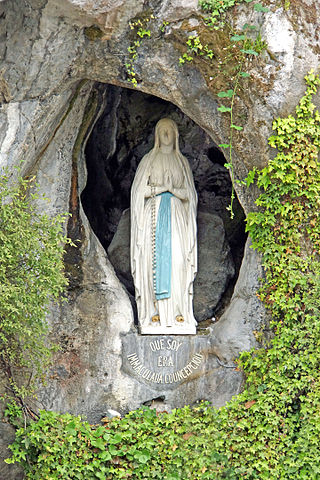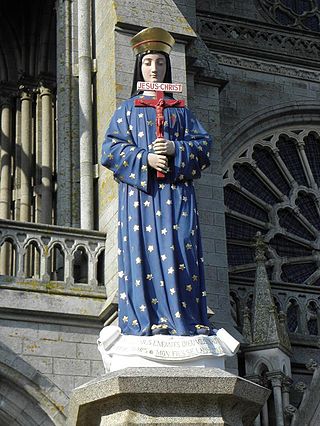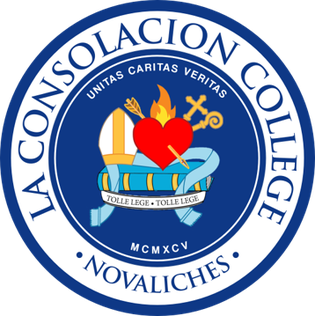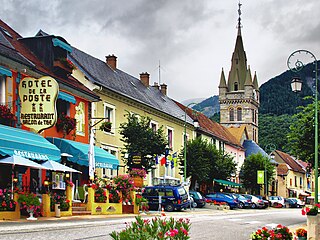
A shrine to the Virgin Mary, or Marian shrine, is a shrine marking an apparition or other miracle ascribed to the Blessed Virgin Mary, or a site on which is centered a historically strong Marian devotion. Such locales are often the destinations of Christian pilgrimages.

A Marian apparition is a reported supernatural appearance by Mary the mother of Jesus, or a series of related such appearances during a period of time.

Our Lady of Fátima is a Catholic title of Mary, mother of Jesus, based on the Marian apparitions reported in 1917 by three shepherd children at the Cova da Iria in Fátima, Portugal. The three children were Lúcia dos Santos and her cousins Francisco and Jacinta Marto. José Alves Correia da Silva, Bishop of Leiria, declared the events worthy of belief on 13 October 1930.

Our Lady of La Salette is a Marian apparition reported by two French children, Maximin Giraud and Mélanie Calvat, to have occurred at La Salette-Fallavaux, France, in 1846.

The Nativity of the Blessed Virgin Mary, the Nativity of Mary, Marymas or the Birth of the Virgin Mary, refers to a Christian feast day celebrating the birth of Mary, mother of Jesus.

Our Lady of Lourdes is a title of the Virgin Mary. She is venerated under this title by the Roman Catholic Church due to her apparitions that occurred in Lourdes, France. The first apparition of 11 February 1858, of which Bernadette Soubirous told her mother that a "Lady" spoke to her in the cave of Massabielle while she was gathering firewood with her sister and a friend. Similar apparitions of the "Lady" were reported on 18 occasions that year, until the climax revelation in which she introduced herself as: "the Immaculate Conception". On 18 January 1862, the local Bishop of Tarbes Bertrand-Sévère Laurence endorsed the veneration of the Blessed Virgin Mary in Lourdes.

Our Lady of Pontmain, also known as Our Lady of Hope, is the title given to the Virgin Mary following her apparition at Pontmain, France on 17 January 1871.

Flores de Mayo is a festival held in the Philippines in the month of May. It is one of the May devotions to the Blessed Virgin Mary and lasts for the entire month.

The Diocese of Grenoble–Vienne-les-Allobroges is a Latin Church diocese of the Catholic Church in south-eastern France. The diocese, erected in the 4th century as the Diocese of Grenoble, comprises the department of Isère and the former canton of Villeurbanne (Rhône), in the Region of Rhône-Alpes. In 2006, the name was changed from the diocese of Grenoble to the diocese of Grenoble–Vienne. The current bishop is Jean-Marc Eychenne, appointed on September 14, 2022.

Our Lady of La Vang refers to a reported Marian apparition at a time when Catholics were persecuted and killed in Vietnam. The Shrine of our Lady of La Vang is situated in what is today Hải Phú commune in Hải Lăng District of Quảng Trị Province in Central Vietnam.
Our Lady often refers to:

La Consolacion College – Novaliches, also known by its former name La Consolacion College - Deparo or colloquially LaCo [pronounced as /lakô/]) is a private Catholic basic and higher educational institution administered by the Augustinian Sisters of Our Lady of Consolation (ASOLC).< in Caloocan, Philippines. It was founded in February 1995 and is one of the two La Consolacion schools in the city of Caloocan, and one of the 24 schools owned and administered by the Augustinian Sisters.

Françoise Mélanie Calvat, religious name Mary of the Cross, was a French religious sister in the Roman Catholic church. She and Maximin Giraud were the two seers of Our Lady of La Salette.
Pierre Maximin Giraud was a Marian visionary of Our Lady of La Salette.

Corps is a commune in the department of Isère in southeastern France.

Our Lady of Manaoag is a Roman Catholic title of the Blessed Virgin Mary venerated in Manaoag, Pangasinan, the Philippines. The sacred statue is referred to as Apo Baket in the native language of local devotees.
La Salette of Roxas College, is a private Catholic, coeducational basic and higher education institution run by the Missionaries of Our Lady of La Salette in Vira, Roxas, Isabela, Philippines. It was founded by the La Salettes on September 17, 1958. It is the only Catholic school in the municipality and is one of the leading educational institution in Isabela.

Our Lady of Peñafrancia is an image of the Blessed Virgin Mary in the Philippines. The Marian image is permanently enshrined in the Minor Basilica of Our Lady of Peñafrancia in Naga, Camarines Sur.

Our Lady of the Most Holy Rosary – La Naval de Manila is a venerated title of the Blessed Virgin Mary associated with the same image in the Philippines. Pious believers believe that the Virgin's intercession under this title helped to defeat the invading forces of the Protestant Dutch Republic during the Battles of La Naval de Manila in 1646.

Our Lady of the Rosary of San Nicolás is, in Catholicism, a title of veneration of the Blessed Virgin Mary associated with a reported private revelation to Gladys Quiroga de Motta, a middle-aged housewife, beginning in the 1980s in the city of San Nicolás de los Arroyos, Argentina. Quiroga said that she was tasked with promoting devotion to the Mother of God under this title, with an emphasis on key passages in the Bible and a particular mystical stellar symbolism.

















